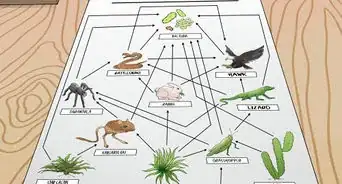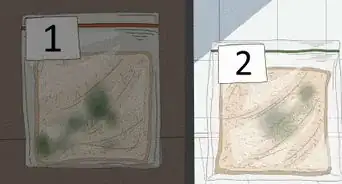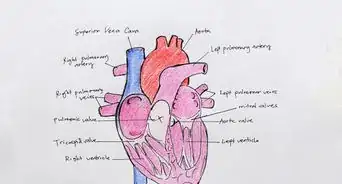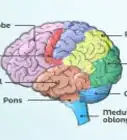This article was co-authored by Bess Ruff, MA. Bess Ruff is a Geography PhD student at Florida State University. She received her MA in Environmental Science and Management from the University of California, Santa Barbara in 2016. She has conducted survey work for marine spatial planning projects in the Caribbean and provided research support as a graduate fellow for the Sustainable Fisheries Group.
wikiHow marks an article as reader-approved once it receives enough positive feedback. In this case, 96% of readers who voted found the article helpful, earning it our reader-approved status.
This article has been viewed 38,737 times.
Biology is the study of life and the processes that govern it. While this can get quite complex, gaining a working knowledge of basic concepts will help you to understand the more complicated ideas. The first steps to gaining this understanding are reading the chapter, making notes, and finding ways to apply biology to your life.
Steps
Reading the Information Effectively
-
1Find a quiet reading space. To successfully read from your biology book, you should look for a quiet place. Try to leave any distractions, such as TV or cell phones, turned off. This will help you focus on the biology concepts that you are reading about.[1]
- Going to the library or an open classroom is always a good option when seeking a reading space.
-
2Skim the section titles. Jumping straight into the first paragraph might be overwhelming for some. Instead, read through the section titles for that chapter to gain a rough idea of what concepts you will be reading about. This will mentally prepare you to read the material and understand how the concepts fit together.[2]
- For example, a chapter on mitosis might have sections for interphase, prophase, prometaphase, metaphase, anaphase, telophase, and cytokinesis.
Advertisement -
3Utilize any summary information that the book provides. Many biology books will have a chapter summary or a page listing key terms at the end of the chapter. These pages summarize biological concepts discussed in the chapter. Read over this material to have an idea of what the main points of the chapter will be.
-
4Read the material. Once you have read your section titles and settled into your quiet space, it’s time to get to work. Start reading the first section of the chapter. Read at your own pace and make sure that you are understanding each section before moving forward.[3]
- Sometimes, it is a good idea to commit to reading one section at a time instead of reading the whole chapter at once.
- Re-read sections as needed.
-
5Examine graphs, charts, and images. Much of biology is better explained with visuals. Instead of skipping over charts and images, take the time to look at them. They say a picture is worth a thousand words, and in biology, this is often true.
- One of the most popular images in biology is the diagram of a cell. This shows the major structures and functions of the cell.
- You might also encounter a chart depicting the Krebs Cycle.
Taking Notes on the Chapter
-
1Make reading notes. As you read, jot down important biological concepts and details. Your reading notes do not have to be organized at first, as long as you can go back and understand what you wrote. Also, write down any questions you have or things that you do not understand in your biology chapter.[4]
- For example, if you come across a word you don’t know (e.g. lipid), write it down.
- If taking notes as you read interrupts your flow and makes it more difficult for you to understand how the material or themes are connected, read the chapter through the first time without stopping. Then, go back and read it a second time while taking notes.
-
2Summarize graphs or images. Writing out the concepts covered in a graph or image is a great way to check your understanding. Make notes of the graphs and images that are covered in your text. You can also draw any images that you would like to have in your notes.
- Diagrams of particular structures, like the golgi apparatus, would be good images to redraw in your notes.
-
3Organize your notes. After you read the entire chapter, you should revise your notes. Rewrite all of your reading notes in complete sentences and organized bullet points. Add your diagrams and/or image summaries in with the concepts that they explain. Be sure to put everything in your own words.[5]
-
4Utilize common biology study aids. Put your notes into folders based on subject matter. It may help to even color code the folders. Break the notes down into flashcards with a question on one side and an answer on the other. You can also make flashcards with a term or image on one side and the definition or explanation on the other. These tools will help you understand the chapter you read more completely.
- A colored folder system might use a green folder for things related to genetics, a red folder for cell structures, and a yellow folder for metabolism.
- A note card might have the word “anaphase” on one side and a description of what happens during anaphase on the other side.
Digging Deeper into Biology
-
1Define unknown words. Context clues can give you a good idea of what a word might mean. However, biology is a science with very specific terms. Look up each word that you do not know and write out its proper definition. This will keep you from being tripped up when you see the word in a new context.
- You can often find the definition of these words in the textbook glossary. If you come across a word that isn’t in the glossary, look it up in a dictionary or online.
- You might need to look up words like “glycosylation” or “respiration” to fully understand the chapter of biology that you are reading.
-
2Look for background information. Many biological processes can only be understood with the right background information. Sometimes, that background will come from other biology concepts, but you may need to study other subjects as well. To gain the needed background information, go to the library or look online. Look through textbooks in other subjects such as chemistry or utilize resources such as Khan Academy online.
- For example, if you are studying metabolism, a background in chemical processes will be useful. Some of this information may be given in the chapter, but you may be assumed to know some of it.
-
3Imagine how you could apply this information. Many people find biology difficult to connect with. In order to understand the concepts and enjoy what you are reading, you will need to find an application for biology. The application should match something you enjoy and do well in. Common topics are things like health sciences and biochemistry.[6]
- If you enjoy math, you could look at biological concepts as they apply to mathematical concepts. A good application for this would be to determine the rate at which cells grow given different conditions.
- You could also consider how these biological concepts affect everyday life. For example, when you are studying genetics, you could think about your own features and the genes that create them.
Getting Help
-
1Utilize tutoring centers. Most schools will have a tutoring center to help students in different subject areas. Schedule an appointment or come in during the time that the biology tutor is available. Tutors are sometimes biology instructors, lab assistants, or students who do exceptionally well in their biology class.
-
2Ask classmates. Be selective when asking classmates to help you out. Ask the students who are doing well in biology as opposed to someone you’re friends with who is also struggling. You can ask for one on one help, or form a study group with several students.[7]
-
3Participate in study groups. There is usually a student in every class who is eager to start a study group. If your biology class doesn’t already have a study group, be the eager learner and start one. You can even create social media pages that keep the group connected and let everyone know when and where meetings will be.[8]
- Come to each study session with your notes, your book, and any homework problems. Ask questions and try to answer others’ questions.
-
4Talk to your instructor. Your biology instructor can be your most valuable resource when you need help. Go to office hours or set up a meeting with your biology instructor. Use this time to ask them about the concepts or applications that you are struggling with in your biology class.[9]
- It always helps if the instructor sees that you are putting in effort. Attend class every day, take advantage of optional study times, and participate in class discussions.
- It might be helpful to record class lectures so you can listen to them again later. Be sure to get your professor’s permission before doing this.
Community Q&A
-
QuestionHow do I remember what I read?
 Community AnswerTaking notes is a great way to engage with the text and remember the things you read. Then review your notes periodically to freshen your memory.
Community AnswerTaking notes is a great way to engage with the text and remember the things you read. Then review your notes periodically to freshen your memory. -
QuestionHow can I make a boring chapter interesting?
 Community AnswerTake frequent short study breaks - say, 5 minutes of break-time for every 20 minutes spend studying the boring chapter. That will keep things a little fresher and keep the monotony from being overwhelming.
Community AnswerTake frequent short study breaks - say, 5 minutes of break-time for every 20 minutes spend studying the boring chapter. That will keep things a little fresher and keep the monotony from being overwhelming. -
QuestionHow do I learn biology?
 Community AnswerYou can go online for classes if you are not school. If you are in school, then talk to your guidance counselor or science teacher about when (what year) you can expect to take a biology class.
Community AnswerYou can go online for classes if you are not school. If you are in school, then talk to your guidance counselor or science teacher about when (what year) you can expect to take a biology class.
Warnings
- Cramming all of the chapter in on the night before an exam rarely works.⧼thumbs_response⧽
References
- ↑ http://www.studyright.net/blog/4-steps-to-reading-a-textbook-quickly-and-effectively/
- ↑ http://www.studyright.net/blog/4-steps-to-reading-a-textbook-quickly-and-effectively/
- ↑ http://www.studyright.net/blog/4-steps-to-reading-a-textbook-quickly-and-effectively/
- ↑ http://www.skillsyouneed.com/write/notes-reading.html
- ↑ http://www.skillsyouneed.com/write/notes-reading.html
- ↑ https://www.reference.com/science/biology-used-everyday-life-59c6ca89d25fe630
- ↑ https://www.examtime.com/blog/study-hacks/
- ↑ https://www.examtime.com/blog/study-hacks/
- ↑ https://www.butte.edu/cas/tipsheets/studystrategies/studybio.html











































































